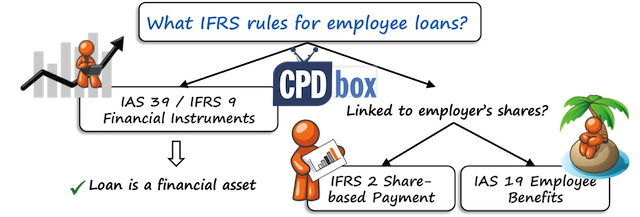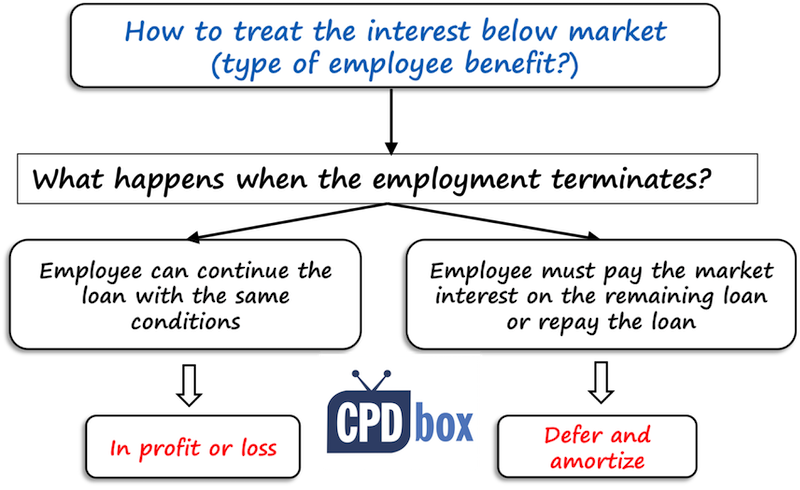How to Account for Employee Loans (interest-free or below-market interest)
After I wrote an article about capitalizing borrowing cost, I got a lot of e-mails asking me actually HOW to account for loans that do not bear the interest rate reflecting market conditions.
In other words, how to account for loans at below-market interest rate, or even interest-free loans.
Such advantageous loans are seen in many circumstances:
- They are provided by a government to support some activities, such as construction of some assets, creation of employment, reimbursement of operating expenses;
- They can be provided by an employer to its employees as one form of employee benefits;
- They can be as well provided by a parent to its subsidiary (or vice versa) in order to support global business, etc.
In today’s article we will focus on the loans provided to the employees, but you can apply measurement criteria to other types of “advantageous” loans, too.
What rules do apply here?
Any loan provided to anybody meets the definition of a financial instrument under IFRS 9 Financial Instruments (and IAS 39, too). Therefore, we will be looking at the rules for initial and subsequent measurement of financial instruments.
However, here’s the other side of the transaction:
Employee loans are provided to a company’s employees and therefore, there is some employee benefit involved, whether falling under the scope of IAS 19 Employee Benefits or IFRS 2 Share-based Payments at some circumstances.

We will assume here that the loans are not connected to some share purchases or anything like that and therefore we will focus on IAS 19 Employee Benefits.
To break the transaction into small easy pieces, let’s come up with a simple example:
Practical example – question
On 1 January 20X1, Goodie Ltd. provided a loan to its employee Mr. Jones amounting to CU 20 000 at interest rate of 1% p.a., repayable in 3 installments of CU 6 800 on 31 December 20X1, 31 December 20X2 and 31 December 20X3. (Note: if you discount 3 payments of 6 800 at 1 %, you should arrive to CU 20 000).
The market interest rate on similar loans is 5%.
How should Goodie Ltd. recognize and measure this loan initially and subsequently?
Initial recognition and measurement of an employee loan
As I wrote above, any loan meets the definition of a financial instrument under IAS 39 or IFRS 9. Both standards require measuring the financial assets initially at their fair value (plus the transaction cost in some cases).
Let’s say that Goodie Ltd. classifies the loan at amortized cost under IFRS 9 (or into “loans and receivables” category under IAS 39).
If the loan would have been made on market terms, then clearly, its fair value at inception would have equaled the loan amount of CU 20 000.
But this is NOT the case.
So what is the fair value of the employee loan?
In order to determine the fair value of the loan, Goodie Ltd. needs to take the following steps:
- Determine the market interest rate for similar instruments (here: 5% p.a.)
- Discount all cash flows from the loan with the market interest rate to arrive at their present value.
The present value of all cash flows is the fair value of the loan.
There are few methods of discounting. Here, let’s apply simple Excel formula “PV” or “present value”, as the cash flows or installments are the same each period. Simply type =PV in the excel file and insert the following parameters:
- Rate = 0.05 (that’s for 5% being the market interest rate)
- Nper = 3 (for 3 regular installments)
- Pmt = – 6 800 (that’s how much employee will repay in each installment)
- Fv = 0 (the future value after repayments, in this case 0)
- Type = 0 (payments are made at the end of period)
Your formula should look something like =PV(0.05;3;-6800;0;0) and if you did it right, the fair value of the employee loan is CU 18 518.
You can do this calculation also in the table format, using the discount factors for the individual year – up to you. I elaborate more on this in my premium training package The IFRS Kit, so if interested, please check it out.
How to treat the difference between loan’s fair value and nominal amount?
There’s a difference between:
- The nominal amount of the loan (or the cash paid to an employee): CU 20 000, and
- The loan’s fair value of CU 18 518
- Difference = CU 1 482
Normally, this would be recognized directly in profit or loss, but here’s the trick:
This difference is an employee benefit and Goodie Ltd. must recognize it in line with IAS 19 rules.
The problem is that IAS 19 does NOT provide any direct guidance on accounting for this form of benefits, and therefore we need to apply general principles of IAS 19.
Determine the type of the employee benefit
First of all, we need to determine the type of the employee benefit under IAS 19 and it depends on the specific terms of the loan agreement.
You should seek answers to the following questions:
What happens when the employee leaves the company? Can he still keep the loan at favorable conditions and continue paying beneficial interest? Or will he need to start paying the market interest rate? Or will the loan become repayable?

If the employee can continue with the loan under the same favorable conditions even after he terminates the employment, it means that the employee benefit has already been earned.
In practical terms – it is recognized straight in profit or loss and the journal entry is:
- Debit Profit or loss – Employee benefits: CU 1 482
- Debit Financial assets – Loans: CU 18 518
- Credit Cash: CU 20 000
If the loan will revert to a market interest rate after the employee leaves, then the benefit has not been fully earned and is available only while the employee provides services to the entity.
In line with IAS 19, an expense should be recognized when the employee provides its services, therefore in this case, we cannot recognize the full amount of CU 1 482 in profit or loss at the time of making the loan.
Instead, we need to defer the expense and allocate it to the periods when the employee provides services.
The journal entry is:
- Debit Prepaid (deferred) expenses for employee benefits: CU 1 482
- Debit Financial assets – Loans: CU 18 518
- Credit Cash: CU 20 000
Amortize the benefit in profit or loss
Then you need to determine HOW you will amortize these prepaid expenses in profit or loss.
Here, several methods are acceptable, but let me show you the method I have seen very frequently. This method looks at the employee benefit as short-term benefit, i.e. settled within 12 months after the employee renders the service.
You can estimate the cost of such an employee benefit in each period as the difference between:
- The interest income for the period based on the fair value of the loan asset (using effective interest method at the market rate of 5%); and
- The interest payable by the employee (at 1%).
I have prepared the simple calculation in the following table:

The specific numbers depend on the year. Let’s draft the journal entries at the end of the year 1:
#1 Interest income on the loan using the effective interest method (at 5%):
- Debit Financial Assets – Loans: CU 926
- Credit P/L – Interest income: CU 926
#2 The 1st installment paid by the employee:
- Debit Cash: CU 6 800
- Credit Financial Assets – Loans: CU 6 800
#3 The employee benefit resulting from the employee loan:
- Debit P/L – Employee benefits: CU 727
- Credit Prepaid (deferred) expenses for employee benefits: CU 727
Any questions or notes? Please leave me a comment right below this article and don’t forget to share it with your friends – thank you! 🙂
Tags In
JOIN OUR FREE NEWSLETTER AND GET
report "Top 7 IFRS Mistakes" + free IFRS mini-course
Please check your inbox to confirm your subscription.
Recent Comments
- Albert on Accounting for gain or loss on sale of shares classified at FVOCI
- Chris Kechagias on IFRS S1: What, How, Where, How much it costs
- atik on How to calculate deferred tax with step-by-step example (IAS 12)
- Stan on IFRS 9 Hedge accounting example: why and how to do it
- BSA on Change in the reporting period and comparatives
Categories
- Accounting Policies and Estimates (14)
- Consolidation and Groups (25)
- Current Assets (21)
- Financial Instruments (56)
- Financial Statements (54)
- Foreign Currency (9)
- IFRS Videos (74)
- Insurance (3)
- Most popular (7)
- Non-current Assets (56)
- Other Topics (15)
- Provisions and Other Liabilities (46)
- Revenue Recognition (27)
- Uncategorized (1)





Hi Silvia, Hoping you are doing easy.
Please could you tell us the paragraph of the IAS 19 or any other standard that specifies the deferral if the employee is not favoured with the low market rate if he/she ceases his employment with the entity.
Thanks in advance , take care…
#1 Interest income on the loan using the effective interest method (at 5%):
Ma’am in the above JV won’t it increase the income of the company as we credit to p&l.
Hi. Many thanks for a very informative and helpful topic. In the public sector in our country, we’ve seen employers advance both cash and in-kind benefits to government employees as follows:
(A) Benefits for employee’s own training or education: Cash in the form of paid leaves/sabbaticals as well as allowances to cover education/training and related travel and accommodation costs, and in-kind such as when the employer pays directly for these on behalf of the employee. Upon completion of their education or training, the employee must continue working for its employer (or, if they transfer, for another government entity) for a certain or a similar period for which they will be also fully paid. If they don’t, they will be required to repay the employer an amount proportionate to the unextinguished part of the required service period.
(B) Benefits in-kind in the form of fully dedicated cars for senior officials who opt to have this rather than a monthly transport allowance. The official gets to choose the make and model of the car, will account for the difference from their own resources if the purchase price of the car they wish to have is above the established price limit, and practically has control over the use of the car as per IFRS 16. The car along with its insurance policy remain in the employer’s name until the official has served at the employer or (if they transfer, at another government entity) for a certain period of time (three or four years) or passes away whichever is earlier, at which time title passes to the official/their survivors.
My questions are:
For (A), would discounting be necessary to comply with IFRS when the agreement between the employer and employee requires the employee to work these advanced benefits off and that only in the event of the employee failing to do so, the employee must repay the employer for the unextinguished period? Based on my understanding of IFRS (particularly IAS 32 and IFRS 9), the employer paid in advance for services and has a prepayment asset rather than a financial asset. Only when the employee fails to serve the required term, the unamortized balance of the prepayment asset becomes repayable and should therefore be reclassified as a financial asset (a receivable). This is typical of all prepayments for goods and services regardless of to whom they are made: suppliers, employees, etc. Another downside to discounting in the case of (A), advanced benefits involve the employer making a series of both regular and irregular payments over a period of time, which would complicate any amortized cost accounting.
Do you agree?
For (B), even though the situation has the indicators of a finance lease, i.e. transfers substantially all the risks and rewards incidental to ownership, at least on the face of it does not meet the definition of a lease because the employee provides services, rather than payments, to the employer to earn the car. However, some argue that the employee is in substance trading their transport allowance (cash) for the car.
How would you account for this situation?—as a finance lease over the life of which the lease receivable is extinguished by offsetting with transport liabilities accrued for the employee, or as a prepaid asset simply amortized as the employee work towards the title.
The deferred employee benefits shall be deferred and amortised as employee benefit in PL when the existing loan reverts to market conditions / the employee provide the services to the entity according to your article. I am wondering if the employee leaves the entity (i.e. the loan reverts to market conditions) , so how they can provide the service to the entity.
Hi!
Thank you for an exciting article, you always deliver great material. One interesting observation is that if the benefit is not cancellable, the difference between what is paid out and the loan’s fair value should be taken in the PnL. This effect is calculated on the whole lifetime of the loan. However, when we are considering credit losses (which is only computed up to the contractually agreed point), one should only include a 12m effect initially. Since we do not have any practical ability to avoid the lifetime credit losses, is there a good logic why we in this case only need to consider 12m, but for the benefit need to consider the full difference?
Dear Silvia,
Thank you for sharing valuable resources as always.
It help us understand the concept completely, if you could share the journal entry under second scenario (revert to market interest if employee resigns). At the moment, i am not able to understand how the final ledger looks like at the end of three year.
Hi, Silvia
The “difference” column in the table should be written as =B-E, not =B-D.
each installment of CU 6 800 paid by the employee includes Principal + Interest, right?
Hi Silvia
How to determine and decide the market interest rate i.e. will we consider a market interest had the employee borrows OR the market interest rate had the employer borrows?
Thanks
Before i read your article i was not know that i must go to these part ( or that IAS 19 ) Contain it
thank you for what you do for us you make IFRS More Clear Not easy but Clear
I translate it to Arabic
Hi Sylvia, I would like you to clarify an issue for me.
If the difference between the fair value and total loan is expense straight away in the P/L on initial recognition.
How are we going to account for the subsequent measurement.-Are we supposed to use the market rate /below market rate finance income charge for the subsequent years?
Thank you.
You need to use the market rate – exactly the one you used to measure the fair value of the loan. I the example above, you need to charge interest amounting to 5%.
so, when we accrued interest at 5% in an account receivable (loan) of 18,518, at the end of the year three the cummulative amount would be = 20,400 which is equal to three 6,800 payments, but I wonder, if we recognise interest revenue in PL in each of the three periods, allegedly the impact if profir or loss is offset ( 1,482 as employee benefit initially and 1,482 of interest revenue throughtout 3 different periods). Am I correct? how can you help me to better understan